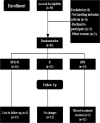Effect of blood flow restriction as a stand-alone treatment on muscle strength, dynamic balance, and physical function in female patients with chronic ankle instability
- PMID: 37933020
- PMCID: PMC10627705
- DOI: 10.1097/MD.0000000000035765
Effect of blood flow restriction as a stand-alone treatment on muscle strength, dynamic balance, and physical function in female patients with chronic ankle instability
Abstract
Background: Blood Flow Restriction (BFR) training has gained popularity as a novel training strategy in athletes and rehabilitation settings in recent years.
Objective: To investigate whether BFR as a stand-alone treatment would affect muscle strength, dynamic balance, and physical function in female patients with chronic ankle instability (CAI).
Methods: Thirty-nine patients with CAI were randomly allocated into 1 of 3 groups: BFR as a stand-alone (BFR) group, BFR with rehabilitation (BFR+R) group, and rehabilitation (R) group. All groups trained 3 times per week for 4 weeks. One week before and after the intervention, strength of muscles around ankle joint, 3 dynamic balance indices: Overall Stability Index, Anterior-Posterior Stability Index, and Medial-Lateral Stability Index, and physical function were assessed via an isokinetic dynamometer, the Biodex Balance System, and the Foot and Ankle Disability Index, respectively.
Results: The strength of muscles around ankle and dynamic balance indices improved significantly in BFR + R and R groups (P < .006), but not in BFR group (P > .006). All dynamic balance indices showed improvement in BFR + R and R groups except the Medial-Lateral Stability Index (P > .006). Foot and Ankle Disability Index increased significantly in BFR + R and R groups (P < .006), however; no improvement occurred in BFR group (P > .006).
Conclusions: The BFR as a stand-alone treatment hasn't the ability to improve the strength of muscles around the ankle, dynamic balance, and physical function in females with CAI compared to the BFR + R or the R program. In addition, the strength of muscles around the ankle correlated significantly with both dynamic balance and physical function in BFR + R and R groups.
Copyright © 2023 the Author(s). Published by Wolters Kluwer Health, Inc.
Conflict of interest statement
The authors have no conflicts of interest to disclose.
Figures
References
-
- Kubota A, Sakuraba K, Koh S, et al. . Blood flow restriction by low compressive force prevents disuse muscular weakness. J Sci Med Sport. 2011;14:95–9. - PubMed
Publication types
MeSH terms
LinkOut - more resources
Full Text Sources


